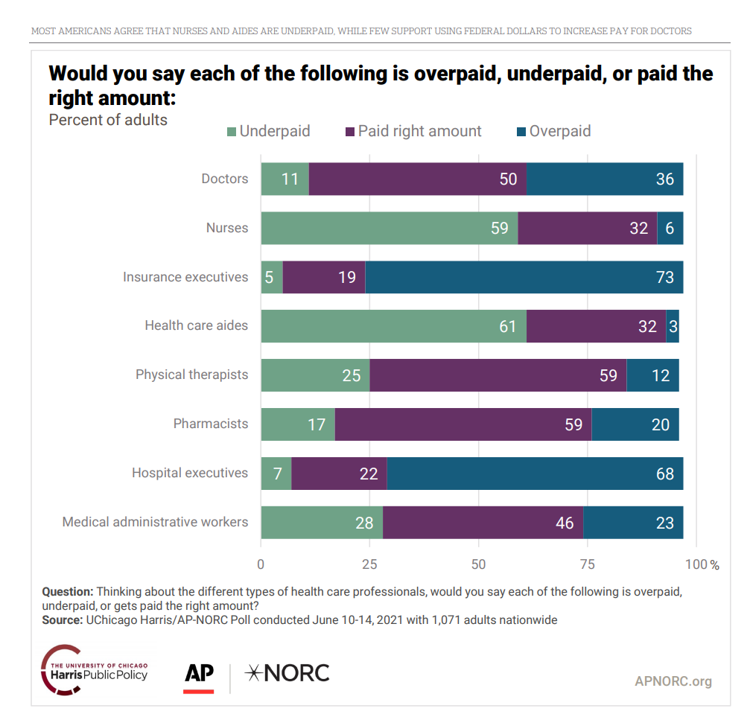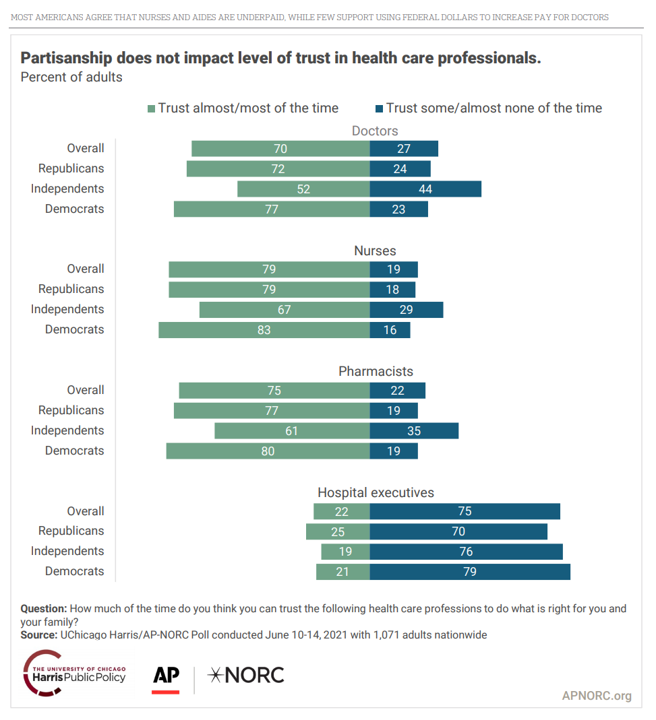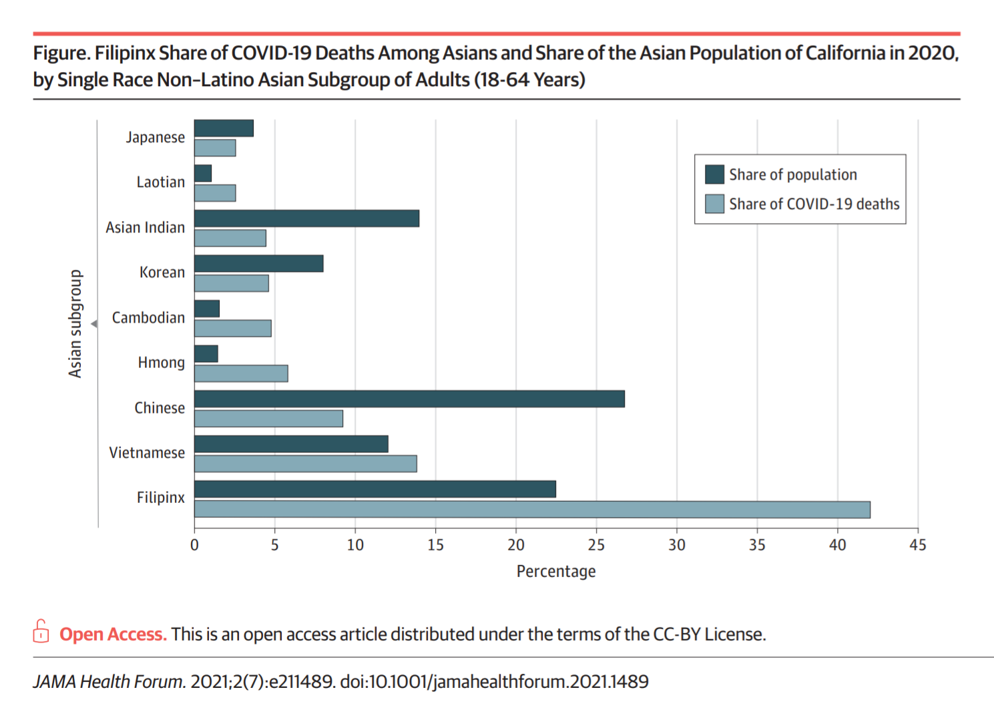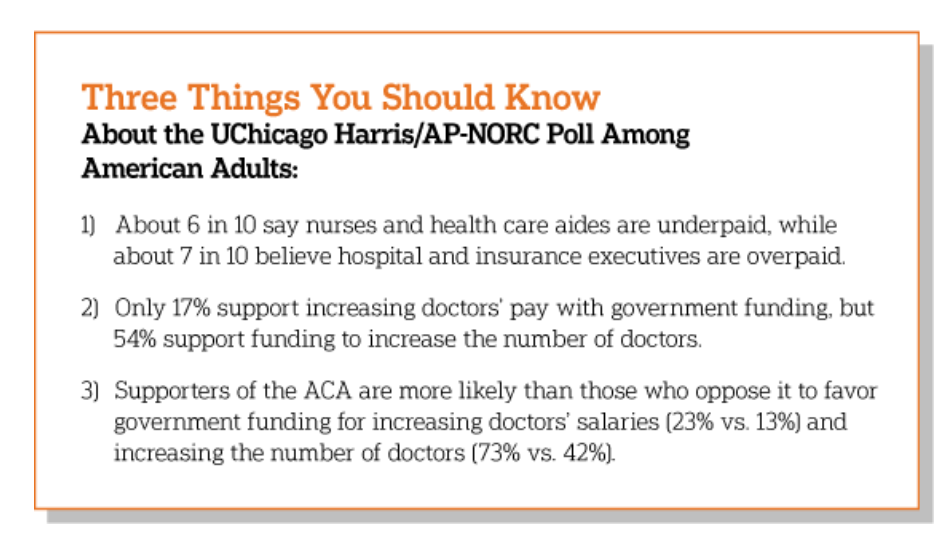A majority of Democrats, Independents, and Republicans agree that nurses are underpaid.
Most Americans across political parties also believe that hospital executives are overpaid, according to a poll from The Associated Press-NORC Center for Public Affairs Research.
 The survey analysis is aptly titled, Most Americans Agree That Nurses and Aides Are Underpaid, While Few Support Using Federal Dollars to Increase Pay for Doctors, .
The survey analysis is aptly titled, Most Americans Agree That Nurses and Aides Are Underpaid, While Few Support Using Federal Dollars to Increase Pay for Doctors, .
Insurance executives are also overpaid, according to 73% of Americans — an even higher percent of people than the 68% saying hospital execs make too much money.
In addition to nurses being underpaid, 6 in 10 Americans believe that health care aides are underpaid.
On the other end of the payment spectrum, 28% of people said that medical administrative workers are underpaid, along with 25% believing physical therapists are underpaid. 17% of people said pharmacists are underpaid.
“The bipartisan consensus around health care workers’ pay provides insights into the types of policies that could gain broad public support,” the survey report opines. “The survey results show that reforms that increase pay for nurses and health care aides or lower the salaries of executives are likely to appeal to both Democrats and Republicans.”
Why might this be people’s shared sentiment, particularly at this time? Because the COVID-19 pandemic has shown us frontline workers dealing with very sick patients for over eighteen months.
 More Americans also trust nurses compared with the three other health care professionals assessed in the poll: overall, 79% of people trust nurses almost or all the time, compared with 75% of people who trust pharmacists, 70% who trust doctors, and only 22% trusting hospital executives.
More Americans also trust nurses compared with the three other health care professionals assessed in the poll: overall, 79% of people trust nurses almost or all the time, compared with 75% of people who trust pharmacists, 70% who trust doctors, and only 22% trusting hospital executives.
The nurse+doctor+pharmacist love among Americans is consistent with the annual Gallup poll of professions, perennially finding that nurses rank tops with people thinking about honesty and ethics.
The second chart arrays this question by political party and level of trust, illustrating concordance again, this time on the issue of trust in health care professionals.
Note that across the three most positively-trusted professionals, slightly more Democrats hold greater trust-equity with them than do Independents or Republicans.
There is an anomaly here when it comes to Independents’ trust in doctors, shown in the top segment of the chart: Only 52% of Independents trust doctors vs. 44% who trust almost none of some of the time — the highest trust-gap in the graph. I don’t have a quick explanation for this chasm among Independent party voters, but it’s worth exploring. There’s a small but noticeable trust-gap with pharmacists, as well, with 35% of Independents lack trust there vs. 19% of both Democrats and Republicans.
The greatest concurrence is the lack of trust in hospital executives across the 3 political party IDs here, shown at the bottom of the graph. Between 7 or 8 U.S. adults, cross-party, lack trust in pharmacists.
The research covered a range of health policy issues, including how health citizens view the Affordable Care Act compared with a single payer health care system or a public option;
The study was fielded in June 2021 among 1,071 U.S. adults aged 18 and over.
 Health Populi’s Hot Points: Clearly, health aides and nurses are highly trusted and valued by Americans, especially appreciated 18 months into the public health coronavirus crisis. The vast majority of people in the U.S. call for these two professions to be paid higher wages, given their front-and-center roles in dealing with COVID-19 and in staffing the health care system in general.
Health Populi’s Hot Points: Clearly, health aides and nurses are highly trusted and valued by Americans, especially appreciated 18 months into the public health coronavirus crisis. The vast majority of people in the U.S. call for these two professions to be paid higher wages, given their front-and-center roles in dealing with COVID-19 and in staffing the health care system in general.
The pandemic’s spiking up in the U.S. has threatened the sustainability of these scarce and dear resources, who work and live in the fourth pillar of the Quadruple Aim: that is, our strategic beacon focused on improving health care outcomes, enhancing the health care experiencing, lowering per capita costs, and ensuring the well-being of our health care workers — clinicians across the medical team.
As COVID-19 has shed a harsh and crucial light on the health inequities in American health care on patients’ disparate outcomes, so the coronavirus has impacted front-line workers of color more negatively.
To that point…the research letter US Health Care Relies on Filipinx While Ignoring Their Health Needs was published in JAMA Health Forum on July 23, 2021.
Subtitled “Disguised Disparities and the COVID-19 Pandemic,” the viewpoint connects dots directly between being a member of the Filipinx community in the U.S. and their higher risk of death due to the coronavirus. The bar chart lays out the stark mortality data for Asian people living in California by ethnicity, illustrating that the Filipinx community has experienced roughly double the share of COVID-19 deaths relative to the share of population, compared with other Asian communities.
In the U.S., 1% of the U.S. population of 2.9 million people are in the Filipinx community; one in four of these people is employed as a front-line health care worker.
The authors point out that Filipinxs comprise about 32% of COVID-19 deaths among nurses in the U.S. despite representing only 4% of nurses nationally. This data was published in a report from the National Nurses United organization, which
We mourn the loss of these nurses, and recognize the healthcare disparity it represents. On a pragmatic note, Filipinx health care workers are a precious resource in the U.S. healthcare system, on whom all Americans rely for care.
“The disproportionate mortality among Filipin nurses is particularly alarming given the historical reason that contributed to the high representation of Filipinxs in the healthcare workforce,” the authors caution, That is the “deliberate” immigration policy that recruited health care workers from the Philippines to address U.S. workforce shortages. “These data suggest that occupational and structural factors have contributed to a greater risk of COVID-19 exposure and transmission among Filipinxs.
Clearly, this community has shouldered a disproportionate share of the frontline health care workflows during COVID, and in U.S. health care for decades. Most Americans, the AP-NORC poll tells us, believe in paying higher wages to nurses and health aides. As we continue to learn from the pandemic, we must attend to this aspect of the care infrastructure to bolster our health care workforce with the resources they need to continue to take care of us, stay well, and remain productive contributors to the U.S. economy.





 Thanks to Feedspot for naming this blog, Health Populi, as a
Thanks to Feedspot for naming this blog, Health Populi, as a